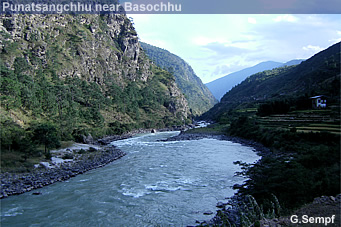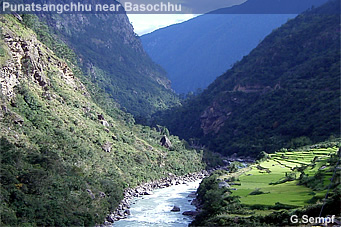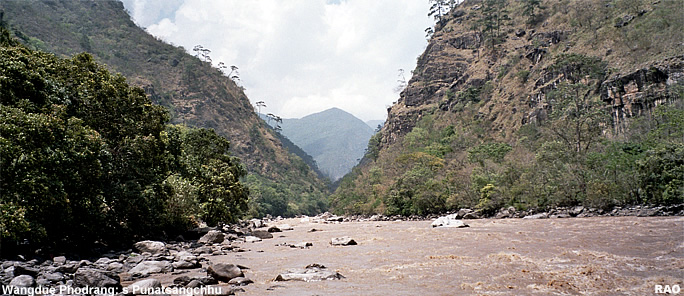 |
Bhutan's
Economy Hydroelectric Power |
 |
Bhutan Information |
|
|
|
 |
|
Punatsangchhu Reports
|
 |
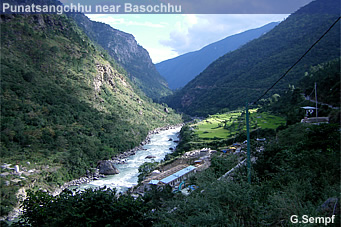 |
Does Punatsangchhu Project affect migratory route of golden mahseer?
River fragmentation results in decline and, in some cases, a complete loss of fish species
Several major hydropower projects that will come up in the Punatshangchhu, Mangdechhu and Sunkosh could affect migration of the golden mahseer (Tor putitora) and Deccan mahseer (Tor khudree), say nature conservationists. |
|
"Dams in these rivers could block their migratory route and prevent the mahseer from coming to Bhutan," said a nature conservationist. Mahseer is mostly found in big rivers like Mangdechhu, Kurichhu, Dangmechhu and Punatsangchhu. "They migrate to the Brahmaputra river in autumn and come back to Bhutan in the spring between April and May. They breed and spawn here," he said.
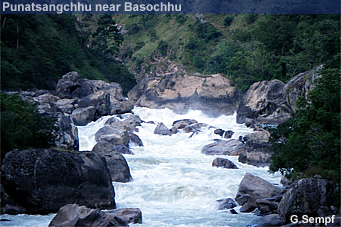 |
According to the food and agriculture organisation (FAO), the mahseer is a legendary sport fish with a very high food value. As a sport fish, it provides supreme recreation to anglers from all over the world, better than salmon. It is known as tiger in waters, because of the fight it musters to wriggle off the hook.
In India, despite their abundance at one time, the mahseer population has been declining in number and size in natural waters and is in serious danger of extinction even after it was categorised as endangered species. Six species off mahseer are found in India. |
|
Golden mahseer has been known to reach 2.75 m (9 ft) in length and about 54 kg (118 lb) in weight.
In Bhutan, understanding of mahseer is very limited said livestock officials. It is not listed as an endangered species in Bhutan. Officials said that study of the impact of the Punatsangchhu dam on mahseer would be carried out soon.
"While hydropower is very important for Bhutan, conservation of mahseer is equally important," said the chief livestock officer, Kencho Wangdi, adding that there could be more than two species of mahseer in Bhutan.
PHPA managing director, R N Khazanchi, said, "As per a detailed project report prepared by WAPCOS, an Indian company, mahseer comes up to a few 100 m upstream of the confluence of Kamichu stream and the Punatsangchhu, which is way downstream of the PHP I dam area."
Kencho Wangdi said that research on breeding of mahseer collected from rivers in Bhutan is in the pipeline. "We have to restock the fish after the construction of the Punatsangchhu dam," he said.
In Bhutan, mahseer the size of a normal adult man were spotted in the past. "But after the outbreak of Lake Lugge in 1994, we didn't see any of such size," said Kencho Wangdi. "If we have to maintain healthy river diversity, everyone should work together for a sustainable ecosystem especially in view of the dams coming up in the future," he said.
Livestock officials said that earlier studies on the mahseer and mitigation works during the construction of the Kurichhu, Chukha and Tala hydropower dam were done without informing or consulting the livestock department.
"The fish ladder constructed at the Kurichhu is a death trap," said Kencho Wangdi. But Druk Green power managing director Tshewang Rinzin said the Kurichhu fish ladder was functioning well. "Fishes are migrating in spring and autumn although we haven't studied the extent of migration," he said. The Chukha and Tala dams don't have a fish ladder. A fish ladder is a structure designed to allow fish the opportunity to migrate upstream over or through a barrier.
Different species of mahseer occupy different ecosystems ranging from tropical waters, where summer temperatures reach 35°C, to sub-Himalayan regions, where the temperatures fall to 6°C.
About 37 fish species are found in rivers of Bhutan, said fishery officials. The brown trout, brought to Bhutan in 1930 from Kashmir, India, and the rainbow trout from Kashmir, last year are exotic fishes.
| Source: Kuensel, Bhutan's National Newspaper, by Kinga Dema , November 2009 |
 |
| Information on Bhutan |
 |
|





